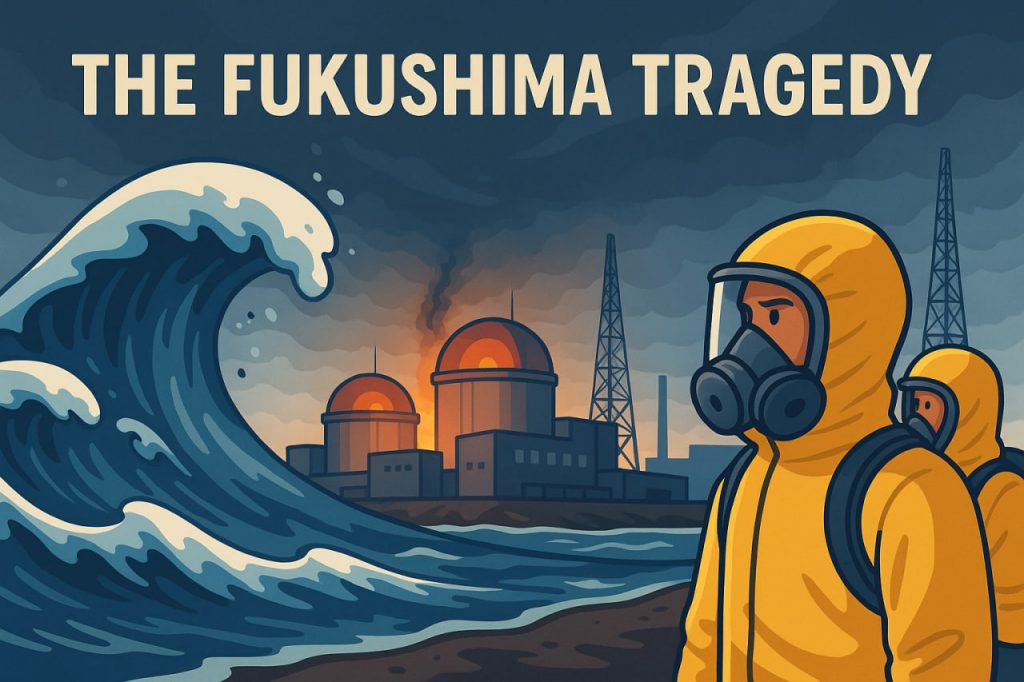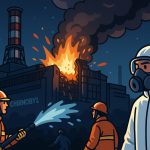On March 11, 2011, the world witnessed one of the most devastating technological disasters since Chernobyl—the Fukushima Daiichi nuclear accident in Japan. Triggered by one of the most powerful earthquakes ever recorded, followed by a massive tsunami, the disaster highlighted the delicate balance between human engineering and the forces of nature. While Japan’s advanced infrastructure prevented greater loss of life from the natural disaster itself, the subsequent nuclear crisis revealed vulnerabilities in even the most modern safety systems and reshaped the global debate on nuclear power.
How the Disaster Unfolded
At 2:46 p.m. local time, a magnitude 9.0 earthquake struck off Japan’s northeastern coast, shaking buildings across the nation. The quake caused automatic shutdowns at the Fukushima Daiichi Nuclear Power Plant, but within an hour, a 15-meter-high tsunami—far exceeding design expectations—crashed into the coastline. The powerful wave overwhelmed the plant’s seawall, flooding backup generators and disabling critical cooling systems. Without cooling, the temperature in the reactors began to rise uncontrollably. In the following days, hydrogen explosions in three reactor buildings released radioactive material into the air, forcing tens of thousands of residents to evacuate.
The Human and Environmental Impact
More than 160,000 people were evacuated from the surrounding region, many never to return. Although the radiation release at Fukushima was much smaller than at Chernobyl, contamination still affected farmland, forests, and coastal waters. Fish and agricultural exports were banned for months, and the cleanup effort continues to this day. The psychological toll on displaced families, combined with fear and uncertainty, led to what experts call “nuclear trauma”—a combination of anxiety, stigma, and social isolation. Tragically, many elderly evacuees died from stress-related conditions, not radiation itself.
The Scale of the Crisis
The Fukushima disaster released significant levels of cesium-137 and iodine-131, both radioactive isotopes with long-term health implications. However, swift evacuation and Japan’s transparency helped prevent large-scale radiation sickness. According to the World Health Organization (WHO), the overall public health impact was limited compared to Chernobyl, but the psychological and social consequences were profound. The decontamination and decommissioning process is expected to last up to 40 years, involving thousands of workers and advanced robotics to safely dismantle the reactors.
Causes and Preventable Factors
Investigations revealed that while the earthquake was unavoidable, much of the damage could have been mitigated. The plant’s seawall was too low, and its emergency generators were placed in flood-prone areas. Engineers had long warned of potential tsunami risks, but economic and political pressures delayed improvements. The Fukushima disaster, therefore, was not only an act of nature but also a failure of foresight—a lesson in how human complacency can amplify natural disasters.
Expert Perspectives
Nuclear engineer Dr. Kenji Sumita stated, “The Fukushima accident was a wake-up call reminding us that safety must evolve faster than technology.” Similarly, Dr. Shunichi Yamashita, a medical expert on radiation health, emphasized that transparent communication is as crucial as technical safety: “Fear spreads faster than radiation.” Their insights underline that public trust and preparedness are as essential as physical infrastructure in managing crises.
The Cleanup and Recovery Efforts
Japan launched one of the most complex decontamination and reconstruction efforts in history. Engineers built a massive ice wall underground to prevent contaminated water from leaking into the ocean. Specialized robots entered the reactors to assess damage, though many failed due to extreme radiation. Entire towns were dismantled, cleaned, and rebuilt. Despite these efforts, radiation levels remain too high in some areas, and debates continue over what to do with treated radioactive water, which Japan began releasing into the Pacific Ocean under international supervision in 2023.
Global Consequences and Policy Shifts
The Fukushima tragedy had a global ripple effect. Many countries, including Germany and Italy, accelerated plans to phase out nuclear power. Others, like France and the United States, reexamined safety protocols and reactor designs. The International Atomic Energy Agency (IAEA) strengthened international safety standards, and Japan implemented sweeping reforms in its nuclear regulation system. The disaster also sparked renewed investment in renewable energy, pushing Japan to become a leader in solar and hydrogen power.
Lessons from Fukushima
Fukushima’s legacy is one of humility and perseverance. It demonstrated that even advanced societies must respect the unpredictable power of nature. It also reminded the world that energy policy cannot rely solely on technology—it requires ethics, transparency, and adaptability. Today, Fukushima stands as both a warning and a symbol of resilience. Thousands of workers continue rebuilding, and renewable energy initiatives now honor the lives disrupted by the tragedy, shaping a cleaner, safer future.
Interesting Facts
- The earthquake that triggered the disaster shifted Earth’s axis by about 10 centimeters.
- Over 500,000 people were initially evacuated from the region due to the combined quake, tsunami, and nuclear threat.
- The cost of cleanup and compensation is estimated to exceed $200 billion.
- The radiation released was about one-tenth of Chernobyl’s total.
- Japan now runs annual nationwide evacuation drills simulating nuclear emergencies.
Glossary
- Reactor Core – The part of a nuclear reactor where fission reactions occur, producing heat.
- Cesium-137 – A long-lived radioactive isotope that contaminates soil and water.
- Iodine-131 – A radioactive isotope that affects the thyroid gland.
- Tsunami – A massive ocean wave caused by undersea earthquakes or landslides.
- Decommissioning – The process of safely dismantling a nuclear facility.
- Containment – Structures or systems designed to prevent radioactive leaks.
- Nuclear Trauma – Psychological distress resulting from radiation fear and displacement.
- IAEA (International Atomic Energy Agency) – The global organization overseeing nuclear safety.
- Renewable Energy – Energy from sustainable sources such as sunlight, wind, or water.
- Ice Wall – A frozen barrier built to contain groundwater contamination at Fukushima.


